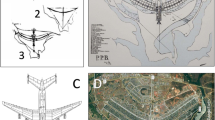Abstract
Two players are endowed with resources for setting up N locations on K line segments of identical length, with N > K ≥ 1. The players alternately choose these locations (possibly in batches of more than one in each round) in order to secure the area closer to their locations than that of their rival’s. The player with the highest secured area wins the game and otherwise the game ends in a tie. Earlier research has shown that, if an analogous game is played on disjoint circles, the second mover advantage is in place only if K = 1, while for K > 1 both players have a tying strategy. It was also shown that these results hold for line segments of identical length when rules of the game additionally require players to take exactly one location in the first round. In this paper we show that the second mover advantage is still in place for K ≥ 1 and 2K − 1 ≤ N, even if the additional restriction is dropped, while K ≤ N < 2K − 1 results in the first mover advantage. Our results allow us to draw conclusions about a natural variant of the game, where the resource mobility constraint is more stringent so that in each round each player chooses a single location and we show that the second mover advantage re-appears for K ≤ N < 2K − 1 if K is an even number. In all the cases the losing player has a strategy guaranteeing him arbitrarily small loss.
Similar content being viewed by others
References
Ahn HK, Cheng SW, Cheong O, Golin M, van Oostrum R (2004) Competitive facility location: the Voronoi game. Theor Comput Sci 310(1–3): 457–467
Chamberlin EH (1953) The product as an economic variable. Q J Econ 67(1): 1–29
Chawla S, Rajan U, Ravi R, Sinha A (2006) Min–max payoffs in a two-player location game. Oper Res Lett 34(5): 499–507
Cheong O, Har-Peled S, Linial N, Matoušek J (2002) The one-round Voronoi game. In: SCG ’02: proceedings of the eighteenth annual symposium on Computational geometry, ACM Press, New York, NY, USA, pp 97–101
Datta D, Dziubiński M, Roy J (2009) A location game on disjoint circles. Int Game Theory Rev 11(4): 391–406
Dürr C, Thang NK (2007) Nash equilibria in Voronoi games on graphs. In: Algorithms—ESA 2007, 15th annual European symposium, Eilat, Israel, October 8–10, 2007, Proceedings, pp 17–28
Economides N (1986) Minimal and maximal product differentiation in Hotelling’s duopoly. Econ Lett 21: 67–71
Eiselt HA, Laporte G (1989) Competitive spatial models. Eur J Oper Res 39(3): 231–242
Hakimi SL (1983) On locating new facilities in a competitive environment. Eur J Oper Res 12: 29–35
Hotelling A (1929) Stability in competition. Econ J 39(1): 41–57
Prescott EC, Visscher M (1977) Sequential location among firms with foresight. Bell J Econ 8(2): 378–393
Salop SC (1979) Monopolistic competition with outside goods. Bell J Econ 10(1): 141–156
Slater PJ (1975) Maximin facility location. J Res Natl Bur Stand B Math Sci 79: 107–115
Tietz MV (1968) Locational strategies for competitive systems. J Reg Sci 5: 135–148
Tobin RL, Friesz TL, Miller T (1989) Existence theory for spatially competitive network facility location models. Ann Oper Res 18(1): 267–276
Wagener A (2007) Minimax payoffs in sequential one-round location games, discussion paper
Author information
Authors and Affiliations
Corresponding author
Rights and permissions
About this article
Cite this article
Dziubiński, M. Location game on disjoint line segments. Int J Game Theory 40, 231–262 (2011). https://doi.org/10.1007/s00182-010-0236-8
Accepted:
Published:
Issue Date:
DOI: https://doi.org/10.1007/s00182-010-0236-8




